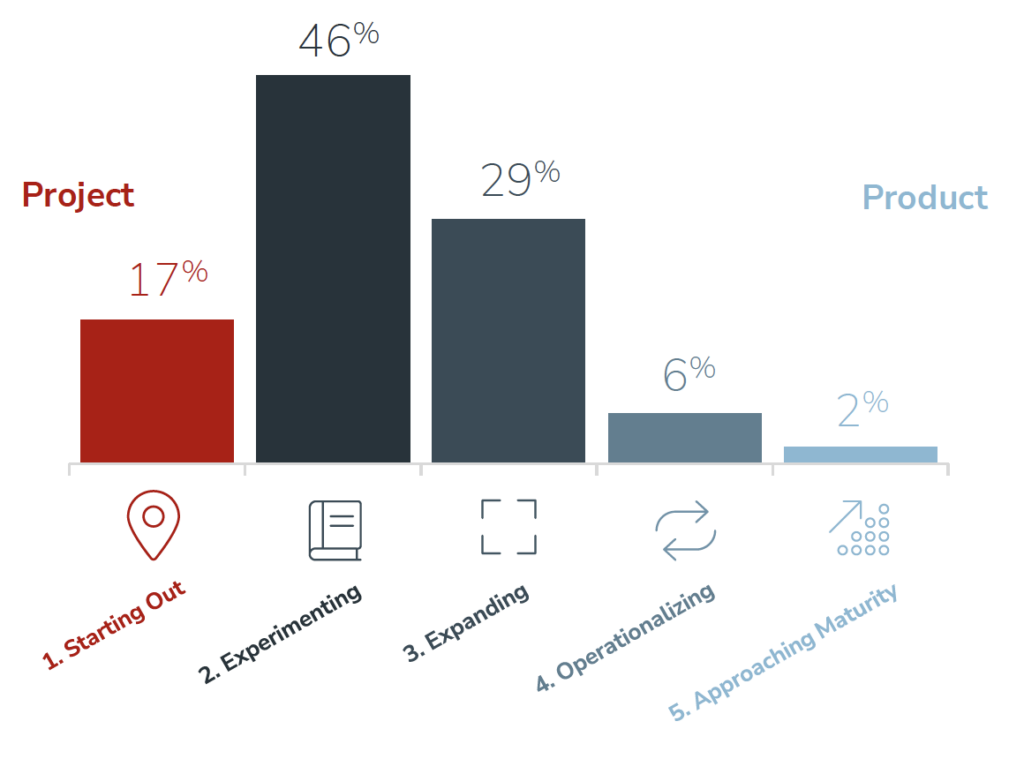
Five years ago, Planview CTA Mik Kersten outlined the “turning point” in his bestselling book, Project to Product: How to Thrive and Survive in the Age of Software with the Flow Framework. He was referring to the ground-breaking shift of digital innovation from the hands of a few tech giants and unicorns to the many enterprise organizations powering the world economy.
Fast forward to today, and the state of digital transformations as a whole “…is still not yet where I had hoped it would be given that the practices, platforms, and tools already in place,” says Kersten. Despite their stated intentions, most organizations are still in the early stages of this shift and have yet to realize the ROI from their efforts. In fact, a McKinsey survey revealed that organizations capture less than one-third of the value that respondents expected to see from their digital transformations and initiatives.
Why are enterprises stalling in the shift from project to product?
Based on insights derived from 3,600 value streams and 326 survey responses from executives and delivery teams, the 2023 Project to Product State of the Industry Report gives us a peek into why an astounding 92% of organizations are struggling to operationalize the transition from project to product.

Figure 1: Where companies are today in their progression across the five project to product stages.
A project to product initiative requires sustained effort across all levels of an organization and top-down sponsorship from the executive team. Without this commitment, consequences include slow delivery and increased technical debt.
Analysis of the survey results identified five attributes that increase the likelihood of success or failure:
#1. Continuously funded build-and-run teams
Team organization and resourcing is the most influential attribute for companies to navigate the shift from project to product successfully. But despite its importance, only 12% of respondents report using a continuous, flexible funding model.
The report also uncovers that business leaders believe IT teams can deliver 10X more than their actual capacity. With such out-of-sync perspectives, business targets are set based on unrealistic expectations, setting the stage for missed commitments, unrealized revenue targets, and employee burnout.
#2. Independent release processes fueled by internal, self-service capabilities
The survey indicates that the second most important factor in achieving a product-oriented model is the approach to managing dependencies. Dependencies are difficult to tackle in software development since value streams are complex, structured more like an airline network than a manufacturing line.
Organizations are more likely to operationalize a product model when all internally consumed capabilities are available as self-service. While most respondents reported having moved away from the SLA-driven execution paths of a project model, the majority still grapple with dependencies. Our research found that 87% of respondents are still impacted by technical, process, and skill dependencies or are delayed by handoffs and coordination with shared services.
#3. Ability to incorporate customer feedback within weeks
The ability to quickly revise planning based on customer feedback increases the likelihood of operationalizing the shift from project to product. Based on survey results, over half (54%) of respondents indicated that some or all of their products have an independent path to production, accompanied by a faster feedback cycle.
Project-oriented organizations tend to have long release cycles with highly governed annual or semi-annual release windows. Operationalizing a product model is much more likely when all products have an independent path to production.
#4. Flow metrics and business outcomes incorporated into operational reviews
According to the survey results, measuring the right metrics determines the likelihood of achieving the later stages of project to product maturity. Direct mapping between delivery team metrics and business outcomes is necessary to support data-driven decision-making and inform strategy.
Incorporating Flow Metrics and business outcomes into regular operational reviews has been proven to increase the likelihood of operationalizing the shift. However, survey responses show this dimension of change poses a significant challenge, with 51% of respondents still measuring IT’s success with quality and cost metrics. Despite being commonly used, Agile, DORA, and Engineering metrics on their own do not increase the likelihood of operationalizing the shift.
#5. Mature product management function that governs product vision, roadmap, and viability
A mature product management function is critical, where product managers act as the long-term custodians of product vision, roadmap, and viability. In project-oriented management, the project plan focuses on the priorities at hand without much consideration for maintaining a healthy mix of Feature, Defect, Risk, and Debt work, or long-term implications. In fact, results show that 80% of value streams do not proactively allocate capacity to technical debt.
A mature product management function maintains a healthy balance in the software portfolio by tying roadmap, team capacity, trade-offs, and prioritization to high-level business imperatives.
Conclusion
In the five years since the publication of Mik Kersten’s Project to Product, the urgency to realize value from transformation efforts has only increased. The shift from project to product is still a significant challenge for many organizations, despite the practices, platforms, and tools available to support it.
The 2023 Project to Product State of the Industry Report sheds light on why many organizations are still struggling to operationalize the shift from project to product. While the attributes identified in the report are crucial for success, it is important to note that this shift requires a cultural change that goes beyond implementing new practices and tools. Organizations must prioritize agility, customer-centricity, and continuous improvement and embrace a product-oriented mindset to fully realize the benefits of this transition. By committing to these key attributes and embracing a cultural shift, organizations can accelerate their digital transformation efforts and position themselves for success in the age of software.
Download the full report to get a more in-depth look at results from the 2023 Project to Product State of the Industry Report




